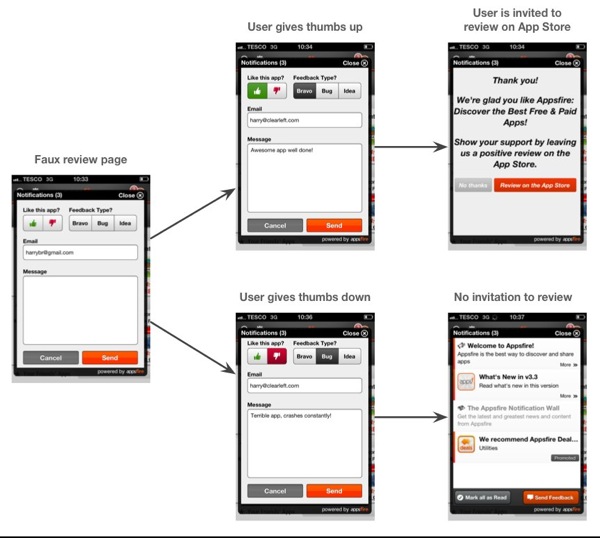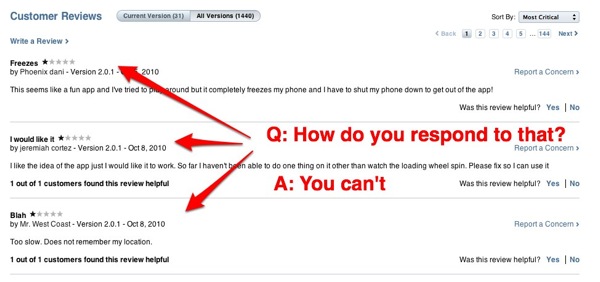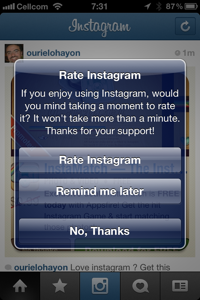A few months ago we launched App booster, our retention toolkit to boost engagement and retention in a mobile app. It is getting serious traction and we ll have some announcements soon.
One of the important features we invented is an advanced, mobile specific, app specific feedback system.
Harry Brignull at 90percentofeverything.com has started an important conversation about “Dark patterns” that manipulate the rating/review system in the App Store. It is followed up by a vivid conversation on Hacker news and it is one of the most discussed topics today. According to Harry, App booster is a Dark pattern and obviously we felt compelled to bring clarity.
Harry’s thesis is that our “Rating booster” is deceptive because the invitation to review an app in the App store only when the review is positive and not when the review is negative. Therefore we are “manipulating” and our practice is in a grey area. Here is below the diagram he published (to be compared with ours below)

This is a deep misunderstanding about what our product is about and how a feedback system should be built.
Current state: how the iTunes review system is broken
Let’s start with the main problem: the review system of iTunes is broken. It is broken because developers have no way to know who is posting a review and worse have no way to repond. Sometimes if you really spend time you can find out, out of the other apps reviewed by the same user, who is the user (a competitor, a user paid by a company to review apps) or looking at his username you can learn more about him (cross checking Twitter or Facebook). But this is time consuming, random and hardly working.
The iTunes review system is broken. There is no dialog possible between users and developers. Worse the system is being gamed by company paying users for reviews or “market test”. Many times they are meaningless.

So how do developers react to that? They include a “Send feedback” button somewhere in the app which most of the time triggers an empty email. We did that at first and we received on a daily basis tens of empty emails. Useless.
What other techniques do developers use to entice users to feedback: they prompt a popup with rather random rules (at launch, after second launch, after a level is achieved in a game) inviting to rate the app in the App store. Below an example i got this morning with Instagram.

The problem with that? It breaks the user experience, and forces the user out of the app at a moment which is likely irrelevant. Some apps are abusing this technique and are displaying this popup over and over. Terrible user experience. Definitely a Dark Pattern..
So that’s the current state. Now let’s get back to App Booster and what we created
APP BOOSTER or the better way to re-establish what is broken
App Booster is a dialog system between users and developers. Developers can broadcast messages to users and users can send feedback to the developers and get their answered right in the app. Where it matters.
Developers can inform, in a non intrusive manner users about the important events of an app, right in the app, in an inbox easily integrated in the app (if you want an example check InstaMatch or Picross HD )
The feedback system has been designed to re-establish what is broken: the direct dialog between the user and the developer. Rather than relying on alternative communication channel touching a minor subset of your user base (emails, Twitter, Facebook) you can now talk to 100% of your user base where it matters
Users can right from the app, send rich feedback in a preset format, in a couple of clicks which is way more convenient than suggesting an email. It is also non intrusive, unlike push popups showing up at random times.
If the feedback is positive, we entice the user to leave, if he wants to, a good review in the App store. For this he has to click, go to the app store and then write a full review there.
If the feedback is negative we thought that the right experience was not to route the user to the app store right away
Why?
We designed App booster so the developer could have a chance to answer the negative feedback before it gets published in the App store. Do not doubt it, an unhappy user will find a its way to the app store and let people know. They already do. App booster will not change that. But at least with App booster the developer has now a chance to answer the user directly in real time.
Harry in his blog show a diagram showing those two cases. But the diagram is incomplete (See above). It only shows the visible part of the feedback system. We completed it below
What happens in reality is that, the developer is alerted in real time by email so he can instantly answer the user and get a chance to answer him about the issue. The reality is that many of the negative feedback is unjustified because it is related to issues independant of the app (low connectivity, app store not working [it happens], hardware has some issue,…]
So App booster is bridging what is broken. If we included a link to the app store from the feedback system. And unlike what is written, App booster is not a REVIEW section. it is a direct message system and it is design and presented as such [which is make it way more efficient]
Appsfire’s Appbooster tool has its own non-App Store review UI (far left) which the user can reach through their notifications panel. [quote from the blog]

Dark Patterns? Boy, no…
So to resume: App booster brings naturally what makes sense for the developer and the user. Many commenters on Hacker News do not seem to consider that as an “evil” practice and we agree
Suggesting like Harry does this should be a reason to reject the app, is not even close to be justified. Its the cleanest way to deal with feedback.
There is far more to say about companies paying third party services to rate their apps, or download their apps from the app store. There is far more to say about apps rewarding the review in the app store. There is far more to say about apps forcing intrusive popups to review their apps (generating unjustified negative reviews because the message is intrusive and disruptive). There is far more to say about how broken the app store review system is
But claiming App booster is a Dark Pattern isn’t right. It is, by far, a much cleaner implementation and more user and developer friendly than any practice we ve been observing so far and hundreds of developers are currently enjoying it.
Let us know your thoughts in comment. We’re continuously improving the product.




